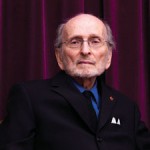Father Abraham
From VANCOUVER MAGAZINE, July 1, 2008
At the tiny hole-in-the-wall Chinese restaurant around the corner from his Point Grey house, Abraham Rogatnick needs no introduction. He is a regular, with his table, his chair. On a sunny afternoon not long ago the owner looked up as he came through the door. She smiled sweetly with a tiny bow of the head, disappeared into the back, and quietly returned with the Yellow Pages for him to sit on.
Rogatnick is an elfin man. Wearing a neatly knotted black tie and white shirt under a red sweater, he could be Billy Crystal’s dad. His face rings a bell, the way character actors’ faces do, though you can’t be sure where you’ve seen them. In Rogatnick’s case, it could have been the crime drama Just Cause, in which he played a nutty old judge on a couple of episodes. Since he broke into acting around 1998, at age 74—propelled by a love for the language of Shakespeare, and with a little more time on his hands at last—he has been steered by his agent away from the stage and into movie and TV roles, more Lear than Romeo.
“I’ve played old men,” he said. “Usually dying old men.”
It occurred to him, as he worked on his chicken soup, that he’d eaten here for four consecutive days, with a different companion each time. Though he retired from the architecture department at UBC in 1985, academics and artists and former students seek him out. Something about him invites questions.
His face registered his pleasure with the soup. “It’s so good today,” he said. “It’s better than it has been for a long time. It must be a new batch.” It was the soup of the day, the soup of the place. If you tried to take it home it wouldn’t be the same soup. He lingered over it. “I eat very slowly,” he said. “I just can’t swallow as fast as everyone else.”
There are people who visibly wield power. And then there are the people who quietly prop them up. Sometimes the backroom partners emerge with a bit of a profile of their own—Raymond Carver’s editor, Helen Keller’s teacher, George W. Bush’s pastor—but more often they don’t. Influence that isn’t particularly interested in fame can easily stay hidden. It’s a different kind of power, exerted by sitting on design panels or crafting inspirational lectures that ignite promising students or eating dinner with men who buy ink by the barrel—but it’s vital to the forward movement of the culture.
Abraham Rogatnick (“Abe” is reserved for his oldest friends) is an architect, a historian, a professor, a public intellectual. Newspaper reporters sometimes reach for goofy catchall phrases like “octogenarian livewire” to describe him because no single label captures him.
Behold Abraham Jedidiah Rogatnick. Who trained at Harvard’s Graduate School of Design under the directorship of Walter Gropius—the Bauhaus founder and one of the pioneers of modern architecture. Who popped into town in the fall of 1955 for a quick visit and was welcomed by the arts community the way a drowner welcomes a floating barrel, and just never left. Who pretty much explained modern-art to Vancouver—after opening the doors to one of the first contemporary art galleries in Canada. (This was six weeks after arriving.) Who helped create what became the Arts Club Theatre, and was parachuted in to restore stability to the Vancouver Art Gallery after its Watergate in 1974. Who invented a “studies abroad” program for architecture students, so they could live in some of the world’s great cities. (When you leave home, as the poet said, you see your own home.) Who chose a water-squeezed tourist mecca for the first platoon of outgoing UBC architecture students—and became one of the world’s foremost authorities on Venice. (That there are plenty of lessons Vancouver can learn from Venice has been one of his chief preoccupations.) Who walked its streets with Buckminster Fuller and Louis Kahn, as their interpreter. Who may have covered more of Vancouver on foot than anyone else alive. Who hiked the Chilkoot Trail with Pierre Berton. Who met Bill Reid when Reid had only recently learned he had some Haida blood in him (and so was phasing out of a career as a CBC broadcaster to explore his roots in art). Who would stand at the intersection of a sample of some of Vancouver’s most important architects and painters of the last century: the landscape architect Cornelia Oberlander, architects Arthur Erickson and Ned Pratt and Ron Thom and Barry Downs and Fred Hollingsworth, painters Bert Binning and Jack Shadbolt and Gordon Smith. Who was present at the birth of West Coast modernism—the closest we have come to an indigenous art movement—and managed to keep his eye on the ball as a new bunch of artists emerged to put Vancouver on the map again. (He remains good friends with Jeff Wall, Stan Douglas, Rodney Graham, Ken Lum, Ian Wallace, Attila Richard Lukacs.) Who is one of a very few men in this city who can get away with wearing a cape. Who tipped the last Vancouver mayoral election. And who claims to be puzzled that people think he’s worth writing about.
Full post:
www.vanmag.com/News_and_Features/City_Life/Father_Abraham?page=0%2C1
